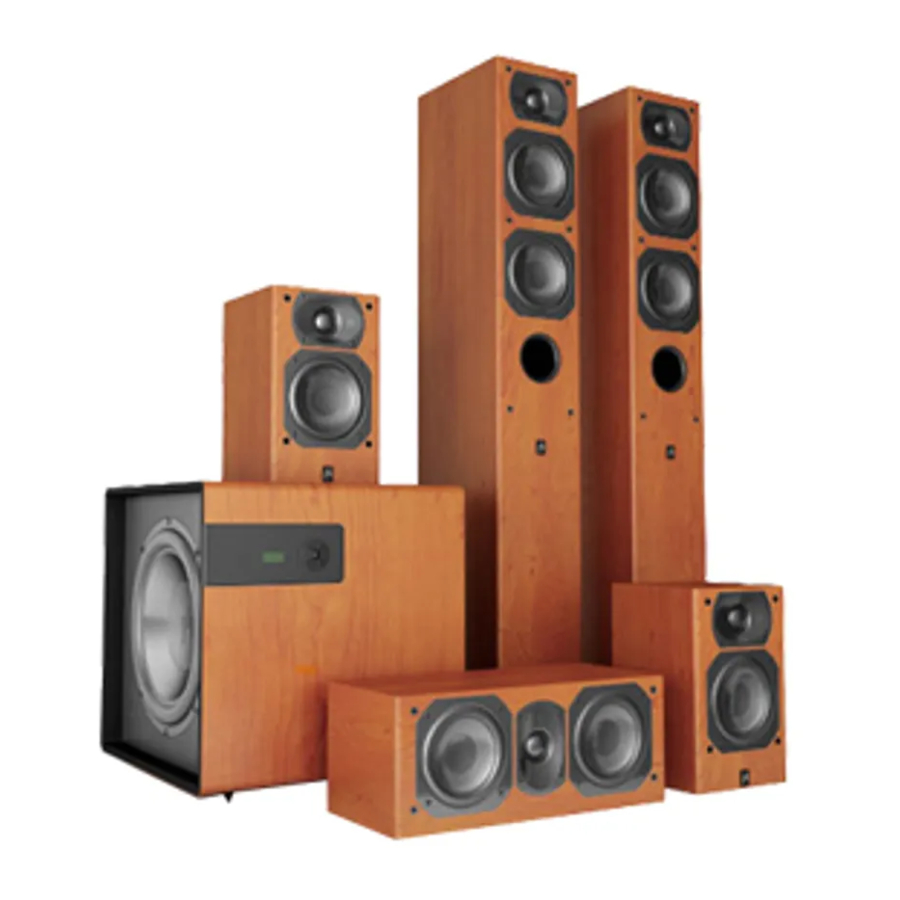
Aperion Audio Intimus Series 4B, 4C, 4BP, 5B, 5C, 4T, 5T - Manual
- Owner's manual (21 pages) ,
- Owner's manual (2 pages)
Advertisement

Features
- 1" Audiophile-grade silk-dome tweeters
- Woven fiberglass composite woofers
- 5-Way gold-plated binding posts
- Anti-Resonant, internally braced cabinets
- Acoustically transparent grilles
- Custom Cast Aluminum Bases (towers only)
Connections
To connect your speaker to your receiver you will need standard 2 conductor, stranded speaker wire. For instructions on installation, please read below.
Preparing the Wire
- Separate the last 4" of your speaker wire into two pieces.
- Strip 1/2" off the shielding off of the end of each wire.
![]()
- Twist the exposed copper strands with your fingers until they are tightly unified. Be sure there are no "flyaway" strands.
![]()
If You're Using Bare Wire
- Unscrew the binding posts on the back of your speaker by turning counter-clockwise.
![]()
- Insert the bare speaker wire into the hole in the binding post and tighten it securely by turning clockwise.
![]()
If You're Using Banana Plugs
- Be sure to follow the instructions on your banana plugs to attach them to the wire.
- Screw the binding posts in completely by turning clockwise.
![]()
- Insert them into the open end of the binding post.
![]()
Note: As you make your connections, be sure to connect the positive terminals on your receiver to the positive terminals on your speakers. Most two conductor wire has screen printing on one side to help you differentiate between the two strands (see image below).

Placement Recommendations
Each room is unique and unless the room was specifically designed to be a home theater, its acoustic properties will not be perfect. However, the following guidelines will help you get the most out of your speakers. Try to match the placement diagrams below as closely as you can. If you're using them as a surround speakers, they should be placed about two feet above the listeners' ears. Also, don't be afraid to experiment with placement. Often a small difference in placement can yield a big improvement in sound.

Receiver Setup
Setting up speakers through your multi-channel receiver only requires a few simple steps. You may have a receiver that has an auto calibration microphone, and while these are convenient, they are not always accurate. For best results, we recommend accessing the setup menu of your receiver and manually setting up the speakers. Most modern receivers use an On Screen Display setup menu that makes setup a breeze.
- In your receiver's setup menu, go to "Speaker Setup" or "Speaker Configuration". The setting for this speaker should be "Small" for bookshelves and centers, and "Large" for tower speakers.
- Select your crossover point. This varies dramatically between speakers, and you should use the value in the speaker specifications(If your speakers are set to "Large" your receiver should automatically bypass the crossover.)
- In the speaker distance menu, measure and input the distance between your primary listening position and your speakers and enter it here.
- In the channel level menu you can set the volume level for each of the speakers in your system. The goal is to adjust each speaker to be the same loudness at your listening position. You can set this by ear, but we recommend using an SPL meter for best results. An SPL meter can be purchased on our website.
www.aperionaudio.com.
Device Specifications
4B Satellite Speaker:
Frequency Response: (+/- 3dB) 120-20,000 Hz
(+/- 6dB) 100-22,000 Hz
Nominal Impedance: 8 Ohms
Sensitivity: 84 dB
Recommended Power: 50 - 150 Watts
Driver Configuration: 2-Way, Enclosure: Sealed, 15mm MDF
Dimensions: 8.75" H x 5.33" W x 5.5" D
Weight: 6.5 lbs.
Receiver Crossover Point: 100Hz
4C Center Channel Speaker:
Frequency Response: (+/- 3dB) 80-20,000 Hz
(+/- 6dB) 70-22,000 Hz
Nominal Impedance: 8 Ohms
Sensitivity: 84 dB
Recommended Power: 25 - 150 Watts
Driver Configuration: 2-Way, Enclosure: Sealed, 15mm MDF
Dimensions: 5.33" H x 12.8" W x 5.5" D Weight: 8 lbs.
4BP Bipole Surround Speaker:
Frequency Response: (+/- 3dB) 100-15,000 Hz
(+/- 6dB) 80-18,000 Hz
Nominal Impedance: 8 Ohms
Sensitivity: 87 dB
Recommended Power: 25 - 200 Watts
Driver Configuration: 2-Way, Enclosure: Sealed, 15mm MDF
Dimensions: 5" H x 12.5" W x 5.8" D
Weight: 8 lbs.
Receiver Crossover Point: 100 Hz
5B Bookshelf Speaker:
Frequency Response: (+/- 3dB) 75-20,000 Hz
(+/- 6dB) 62-22,000 Hz
Nominal Impedance: 6 Ohms
Sensitivity: 84 dB
Recommended Power: 50 - 150 Watts
Driver Configuration: 2-Way, Enclosure: Ported, 18mm MDF
Dimensions: 12" H x 6.75" W x 8" D
Weight: 14 lbs.
Receiver Crossover Point: 80Hz
5C Center Channel Speaker
Frequency Response: (+/- 3dB) 60-20,000 Hz
(+/- 6dB) 53-22,000 Hz
Nominal Impedance: 6 Ohms
Sensitivity: 86 dB
Recommended Power: 50 - 150 Watts
Driver Configuration: 3-Way, Enclosure: Sealed, 18mm MDF
Dimensions: 7.33" H x 19.33" W x 8" D
Weight: 22 lbs.
Receiver Crossover Point: 80Hz
4T Tower Speaker
Frequency Response: (+/- 3dB) 55-20,000 Hz
(+/- 6dB) 45-22,000 Hz
Nominal Impedance: 6 Ohms
Sensitivity: 86 dB
Recommended Power: 50 - 150 Watts
Driver Configuration: 2-Way, Enclosure: Ported, 18mm MDF
Dimensions: 34" H x 5" W x 7.5" D
Weight: 19 lbs.
Receiver Crossover Point: 55-80Hz
5T Tower Speaker
Frequency Response: (+/- 3dB) 55-20,000 Hz
(+/- 6dB) 45-22,000 Hz
Nominal Impedance: 6 Ohms
Sensitivity: 87 dB
Recommended Power: 50 - 200 Watts
Driver Configuration: 2-Way, Enclosure: Ported, 18mm MDF
Dimensions: 38" H x 6.3" W x 8" D
Weight: 36 lbs.
Receiver Crossover Point: 55-80Hz

Documents / Resources
References
Download manual
Here you can download full pdf version of manual, it may contain additional safety instructions, warranty information, FCC rules, etc.
Download Aperion Audio Intimus Series 4B, 4C, 4BP, 5B, 5C, 4T, 5T - Manual
Advertisement












Need help?
Do you have a question about the Intimus Series and is the answer not in the manual?
Questions and answers